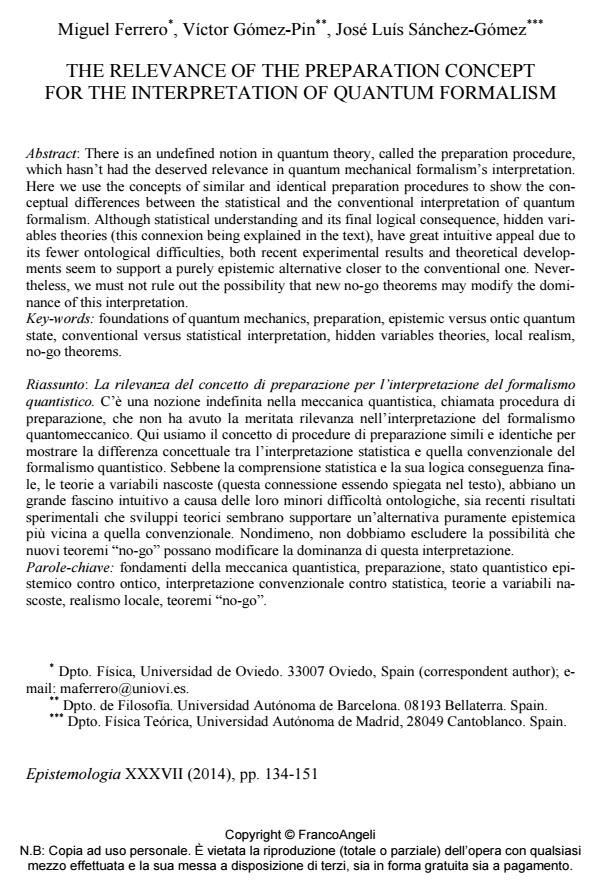The relevance of the preparation concept for the interpretation of quantum formalism
Journal title EPISTEMOLOGIA
Author/s Miguel Ferrero, Victor Gómez-Pin, José Luís Sánchez-Gómez
Publishing Year 2014 Issue 2014/1 Language English
Pages 18 P. 134-151 File size 643 KB
DOI 10.3280/EPIS2014-001009
DOI is like a bar code for intellectual property: to have more infomation
click here
Below, you can see the article first page
If you want to buy this article in PDF format, you can do it, following the instructions to buy download credits

FrancoAngeli is member of Publishers International Linking Association, Inc (PILA), a not-for-profit association which run the CrossRef service enabling links to and from online scholarly content.
There is an undefined notion in quantum theory, called the preparation procedure, which hasn’t had the deserved relevance in quantum mechanical formalism’s interpretation. Here we use the concepts of similar and identical preparation procedures to show the conceptual differences between the statistical and the conventional interpretation of quantum formalism. Although statistical understanding and its final logical consequence, hidden variables theories (this connexion being explained in the text), have great intuitive appeal due to its fewer ontological difficulties, both recent experimental results and theoretical developments seem to support a purely epistemic alternative closer to the conventional one. Nevertheless, we must not rule out the possibility that new no-go theorems may modify the dominance of this interpretation.
Keywords: Foundations of quantum mechanics, preparation, epistemic versus ontic quantum state, conventional versus statistical interpretation, hidden variables theories, local realism, no-go theorems.
- Ballantine L. (1998). Quantum Mechanics, Singapore, World Scientific.
- Bell J.S. (1987). Speakable and Unspeakable in Quantum Mechanics, Cambridge, Cambridge University Press.
- Bohm D., Hiley B. (1993). The Undivided Universe, London, Routlegde & Kegan Paul.
- Bohr N. (1958). Atomic Physics and Human Knowledge, New York, Wiley.
- Boschi D., Branca S., De Martini F., Hardy L., Popescu S. (1998). Experimental realization of teleporting an unknown pure quantum state via dual classical and Einstein-Podolsky-Rosen channels, Physical Review Letters, 80 (6), pp. 1121-1125.
- Brun T., Finkelstein J., Mermin D. (2002). How much state assignments can differ, Physical Review A, 65 (3), pp. 032315 (4 pages).
- Clark A., Chalmers D.J. (1998). The Extended Mind, Analysis, 58, pp. 7-19.
- Colbeck R., Renner R. (2012). Is a system’s function in one to one correspondence with its elements of reality?, Physical Review Letters, 108 (15), pp. 150402 (4 pages).
- Commission Administrative de l’Institut Solvay (ed.) (1928). Electrons et Photons. Rapports et discussions du cinquième Conseil de physique tenu à Bruxelles du 24 au 29 octobre 1927, sous les auspices de l’Institut International de Physique Solvay, Paris, Gauthier-Villars.
- Einstein A., Podolsky B., Rosen N. (1935). Can Quantum mechanical description of physical reality be considered complete?, Physical Review A, 47, pp. 777-780.
- Ferrero M., Gomez-Pin V., Salgado, D., Sanchez-Gomez J.L. (2013). A further review of the incompatibility between classical principles and quantum postulates, Foundations of Science, 18 (1), pp. 125-138.
- Ferrero M., Sanchez-Gomez J.L. (2013). A heuristic classification of physical theories based on quantum correlations, European Physical Journal Plus, June 2013, 128: 65.
- Ghirardi G. (2011). Collapse Theories, The Stanford Encyclopedia of Philosophy, (Winter 2011 Edition), (http://plato.stanford.edu/archives/win2011/entries/qm-collapse/).
- Harrigan N., Spekkens R. (2010). Einstein, incompleteness and the epistemic view of quantum states, Foundations of Physics, 40 (2), pp. 125-147.
- Lewis P., Jennings D., Barret J., Rudolf T. (2012). Distinct Quantum States can be Compatible with a Single State of Reality, Physical Review Letters, 109 (15), pp. 150404 (5 pages).
- London F., Bauer E. (1939). La Théorie de l’ Observation en Mécanique Quantique, Paris, Hermann. Ma X., Zotter S., Kofler J., Ursin R., Jennewein T., Brukner C., Zeilinger A. (2012). Experimental delayed-choice entanglement swapping, Nature Physics, 8, pp. 480-485.
- Megidish E., Halevy A., Shacham T., Dvir T., Dovrat L., Eisenberg H. (2013). Entanglement swapping between photons that have never coexisted, Physical Review Letters, 110 (21), pp. 210403 (4 pages).
- Menary R. (ed.) (2010). The Extended Mind, Cambridge (Mass.), MIT Press.
- Mermin D. (1993). Hidden variables and the two theorems of John Bell, Reviews of Modern Physics, 65 (3), pp. 803-815.
- Mill J.S. (1851). System of Logic, London, J.W. Parker.
- Mittelstaed P. (1998). The Interpretation of Quantum Mechanics and the Measurement Process, Cambridge, Cambridge University Press.
- Pusey M., Barret J., Rudolf T. (2012). On the reality of the quantum state, Nature Physics, 8, pp. 475-478.
- Popper K.R. (1959). The Logic of Scientific Discovery, London, Routledge & Kegan Paul, (German original, 1934).
- Rosenblum B., Kuttner F. (2006). Quantum Enigma. Physics encounters Consciousness, Oxford, Oxford University Press.
- Stapp H.P. (2007). Mindful Universe: Quantum Mechanics and the Participating Universe, 2nd Ed. 2011, Hidelberg/Berlin, Springer.
- Von Neumann J. (1955). Mathematical Foundations of Quantum Mechanics, Princeton, Princeton University Press. (German original, 1932).
- Wigner E. (1967). Symmetries and Reflections, Bloomington, Indiana University Press.
- Coming From Material Reality Miguel Ferrero, J. L. Sánchez-Gómez, in Foundations of Science /2015 pp.199
DOI: 10.1007/s10699-014-9362-2
Miguel Ferrero, Victor Gómez-Pin, José Luís Sánchez-Gómez, The relevance of the preparation concept for the interpretation of quantum formalism in "EPISTEMOLOGIA" 1/2014, pp 134-151, DOI: 10.3280/EPIS2014-001009